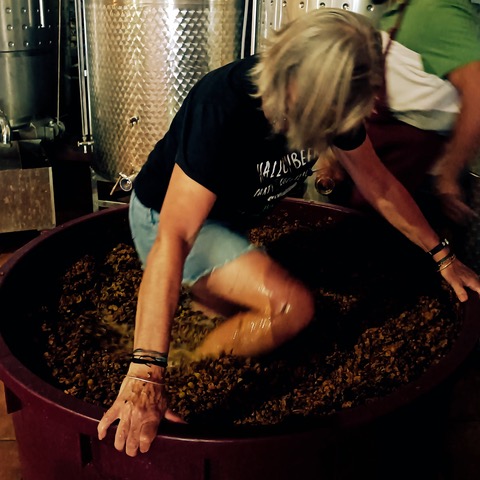
Grape stomping is not for wimps. Photo © Jaime Barrera
You might have seen one of the movie history’s most-known comedy clips with Lucille Ball stepping on wine grapes. In the black and white recording from 1956, she dances around in an enormous barrel on a fictional Italian farm. But the vintage clip refers to a tradition that goes back thousands of years, and which thankfully still is kept alive here in Andalucía.
When our friend and vineyard owner, Enrique Ruiz, told me that they had started the year's grape harvest and would stomp on some of their most selective grapes, I immediately made my feet available for the task.
The following day I headed for his vineyard, La Real Fábrica de Hojalata outside the village of Júzcar (otherwise known for the Smurf movies). Finally, I was to try grape stomping and understand why some winemakers still choose to use this ancient method for their most valuable vintages.
First, we stomp …
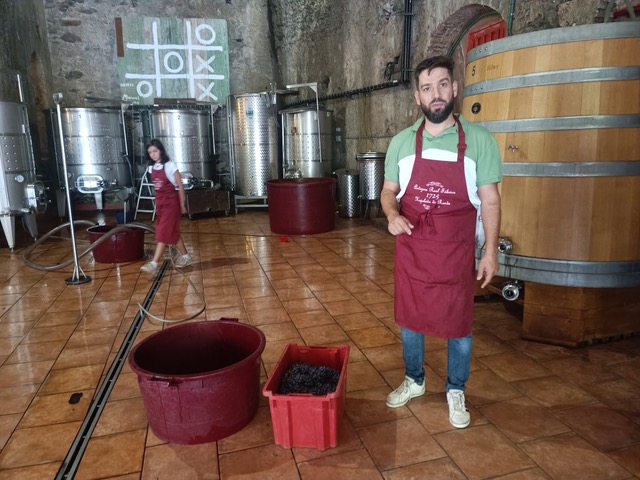
José Manuel in the bodega. Photo © Karethe Linaae
Enrique and his oenologist José Manuel Cózar Cabañas are waiting for me outside the classical bodega. After a proper hosing down of my feet, I get to do a trial round in a smaller tub where the grapes only reach up to my ankles. «These are Tintilla grapes», states Enrique while I get used to the squishy feeling of having crushed fruit between my toes.
The grapes that were picked at the crack of dawn, are gathered in tubs, and pressed by foot so that the raw grape-must comes in contact with the natural wax that grows on the surface of the grape skin. This is how the fermentation process gets activated.
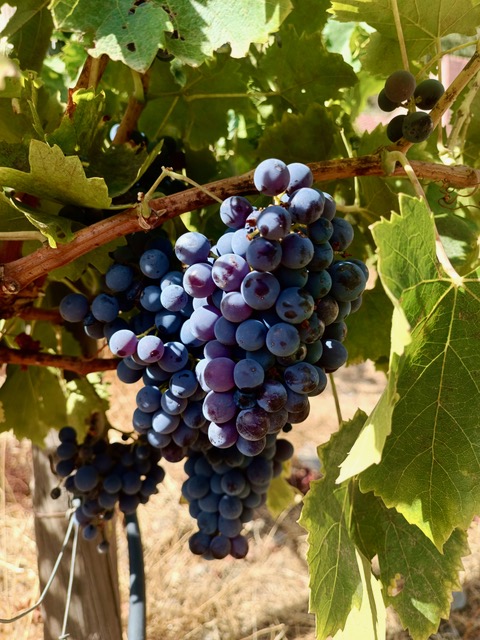
Grapes on the vine with natural wax on the skin. Photo © Karethe Linaae
«We give the grapes a hand with the process so that the wine ends up how we want it», says the Venezuelan oenologist who became smitten by wine while studying chemistry in Seville. The maturing process happens completely without additives. «We keep in the grape stems, so they are in contact with the liquid», he explains as I step out of the small tub.

Wine stomping in miniature. Photo © Jaime Barrera
But the work has only just started. The real stomping is about to begin – this time in a tub that one could almost drown in, which contains 750 kilos of grapes. First, my feet get another hose down, of course. Then, I climb up a small ladder and let myself gradually sink into the bubbling, orange-coloured grape mass which clearly already has been given a couple of stomping treatments. Since the mush reaches well up on my thighs, I can neither run nor dance around in the barrel like they do in Hollywood.
While I stumble around like a drunk (not having touched a drop), it occurs to me that the ancient Greeks had a good idea when they used a rope suspended above, so the stompers could keep their balance. But practice makes perfect, and gradually I get into a sort of Zen rhythm – pushing the foot gently down and then sliding the rest of the body forward. The time-tested process instantaneously raises my appreciation and respect for nature production and the love of wine, as it is completely unreal and ever so cool to be able to stagger about in what just might be La Fábrica de Hojalata's most exclusive future wine!
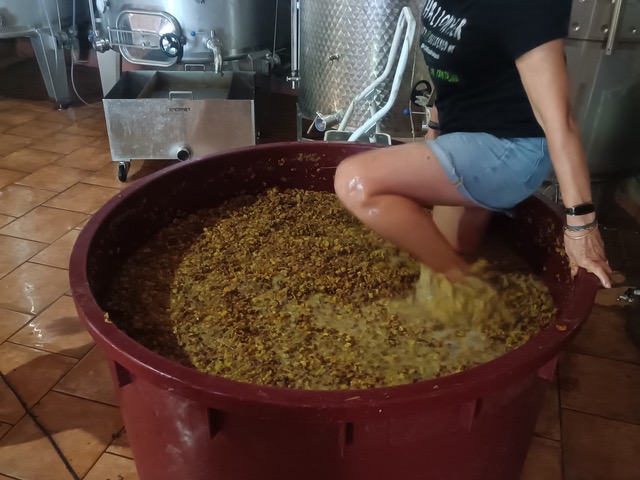
The point is to stay on one’s feet. Photo © Jaime Barrera
This time around, I am crushing the white grape variety Moscatel Morisco in what is the bodega’s pioneer experiment of making what in old Spanish was called vino brisado. In English, it is commonly called orange wine due to the colour, but this can easily be mistaken for a Vino de naranja which gets its taste and flavour by the addition of orange peel. Vino brisado has still not received an official wine classification, despite being the most authentic wine one can possibly produce with a thousand-year-old process.
Only a small fraction of the grapes that are grown on La Fábrica de Hojalata will go through the stepping process, but all their wines are organic nature wines and are pressed with a hand press. In total, they expect approx. 700 bottles of ‘my’ specially stomped, amber-coloured vintage and 2,000 bottles of foot-pressed red Tintilla. In comparison to commercial wine producers, La Fábrica is a tiny winery, only making some 9,000 bottles per year. And while industrial wines are set to age after just 3-4 days, raw wines, or nature wines as they are called, spend up to one month while they ferment at their very own leisurely pace. «Instead of filtering and purifying the liquid, we wait until all the solids fall to the bottom of the batch before we hand press it. This way the wine purifies itself» explains the oenologist.
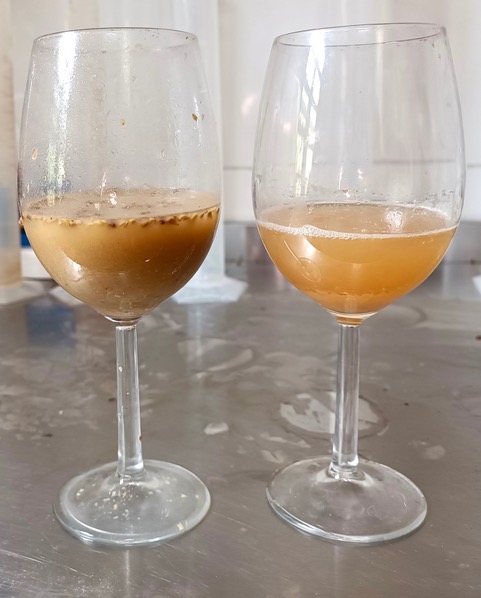
Vino Brisado and pressed raw wine. Photo © Karethe Linaae
José Manuel explains that in industrial winemaking the grapes are rinsed, sorted and stems removed before the juice is pressed in a machine. Thereafter, the first correction will take place when they add sulphur and adjust the sugar- and acidity levels with chemicals. If the must doesn’t have the characteristics and consistency that the producers desire, they will add it. And to ensure that the final product is as ‘clean’ and clear as possible, they remove the naturally occurring yeast and nutrients, and therefore have to add yeast and nutrients in addition to more sulphates. Other chemicals might also be added to ensure that the wine won’t crystallize in the bottle. While this type of mass-produced wine can contain up to 250 ppm (parts per million) of added sulphites, organic wine has a maximum of 115 ppm and raw wine has under 50 ppm. A wine totally free of sulphates does not exist, as all wine has naturally occurring sulphites (under 10 ppm).
Safely out of my first ‘grape bath’, my education on raw wines continues. For health reasons, La Fábrica de Hojalata only uses non-toxic food-grade plastic tubs for the pressing, instead of the traditional wooden tubs. They also use the latest technology in measuring apparatuses. «Raw wine does not mean unclean wine. We make our wine with the least amount of interference, as the natural grape juice has all the wine needs – yeast, acidity, sugar, and nutrients», explains the eager oenologist.

Nature wine from La Fábrica de Hojalata. Photo © Karethe Linaae
More than 8,000 years of history
For the longest time, it was believed that the Romans (think Wine-god Bacchus), the Greeks (who stomped grapes accompanied by flute music) or the Egyptians (who also made wine from dates, pomegranate and figs) were the first to make wine, but we have to go even further back in history to find what we today consider the world’s oldest winemaking technology.
In 2015 a group of archaeologists discovered some clay urns during an excavation of a Neolithic settlement in East Georgia. The urns that were dated to approximately 6,000 BC, had traces of wine and were decorated with paintings of grapes and dancing men. These Qvevri urns are now part of UNESCO’s World Heritage List and are still used in winemaking in Georgia to this day – some 8,000 years later.
If one thinks about it, even Homo Sapiens from prehistoric times who by accident squashed some berries underfoot could have inadvertently started winemaking. Since it now is proven that the Neanderthals in Andalucía made sophisticated art more than 50,000 years ago, couldn’t they also have made yeasted grape juice? We might not be here when the discovery is made, but it wouldn’t surprise me in the least if there is still proof out there that winemaking is even older than we now believe.
Grape stomping anno 2023

First steps. Photo © La Fábrica de Hojalata
Pisado, or Pieage as it is called in French, has been the universal winemaking tradition for thousands of years, but wine producers gradually converted to mechanical pressing – the method that now is the most common for almost all wine producers. So, why in heaven's name do some winemakers still stomp on their grapes, and why has this tradition recently got a renaissance?
First and foremost, I would argue that the trend with boutique hotels, gourmet restaurants and luxury wine tours has increased the demand for exclusive wines. People are willing to pay almost anything for a unique product. Furthermore, the environmental- and sustainability trend has probably also inspired the new wave of grape stomping, not to mention the Slow Food movement. People – at least those who can afford to - want to distance themselves from mass production and get back to the original means and methods.
Why crush the grapes with one's feet?

Oenologist José Manuel explains the process. Photo © La Fábrica de Hojalata
The human foot is the perfect tool for the job. The pressure is light enough that the grape stones don't break, which can give the wine an unwanted bitterness. As most modern grape pressers crush the stones, some port wine producers still use pieage.
There are in fact also practical reasons for using one’s feet. The natural fermentation process that gets initiated can prevent damaging bacteria and mould, at the same time as the stomping circulates oxygen in the tub. The grape skins, stems and stones that come to the surface as one moves the must, contribute to the wine's final colour, taste, and natural aroma.
Traditionalists insist that pressing the grapes by foot allows for better control of the wine's taste profile and produces more complex and textured wines with a unique terroir signature. There are numerous festivals that now include wine stomping. It has become a tourist attraction in for instance Napa Valley and Brooklyn!
If one feels a certain reluctance to drink wine that has been touched by unknown feet, keep in mind that cooks use their hands and that these are often in contact with much more dangerous bacteria than our feet. Furthermore, almost no human bacteria can survive in a wine environment. The fermentation process reduces the oxygen levels, and combined with the natural sugar level that gets converted into alcohol and the grape's natural acidity, all contribute to removing unwanted bacteria and pathogenic organisms.
Wine as poetry
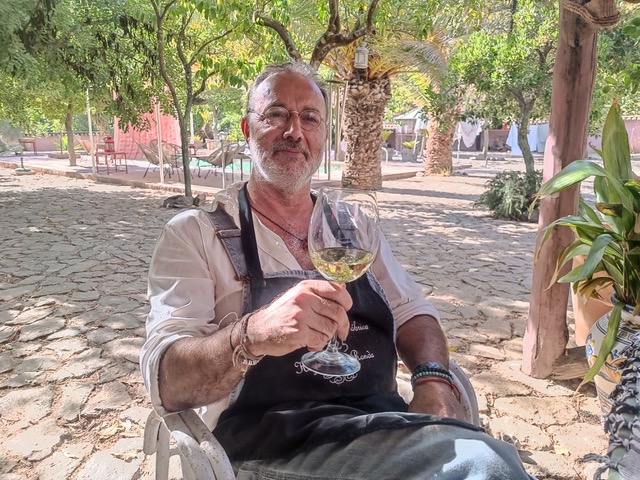
Vineyard owner Enrique Ruiz. Photo © Karethe Linaae
Our little group leaves the bodega and seats ourselves in La Fábrica de Hojalata's beautiful garden while the sun disappears behind the Serranía mountain range. Enrique opens a hand-pressed Moscatel Morisco from 2020 which has a deep amber colour. «When you make a million bottles, you cannot do it the natural way. It would be impossible. And one must admit that there are some excellent industrially made wines, as well”, he admits.
«What happens with raw wine, is that you get hooked», José Manuel interjects. «The more you learn, the more you want to learn. It is a fascinating world.”

Oenologist José Manuel Cózar Cabañas. Photo © Karethe Linaae
We make a cheer for this year's grape harvest, and I cannot resist but wonder if a great oenologist must be not only a good scientist but a bit of an artist.
«There are oenologists who are engineers who learn how wine should be made and follow this in every minute detail. And then there are other oenologists who are more like poets. They have the knowledge and the technique, but they make the wine with love – just like our guy here», says Enrique, referring to the oenologist at his side.
It is very doubtful that such an innovative winemaking method could have even been invented in our times. As the world gets increasingly antiseptic and mechanized, raw wine made by hand and foot, is really both old-fashioned and forward-thinking.
«A raw wine is a wine with a heart that you caress with your feet”, declares the oenologist-poet, and after the day’s stomping adventure, I have to say that I wholeheartedly agree!

The hard-working team outside the bodega after the first hand-pressing of the Moscatel Morisco. Photo © La Fábrica de Hojalata